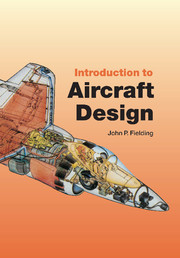Book contents
- Frontmatter
- Contents
- Preface
- Acknowledgements
- 1 Introduction
- 2 Why should we design a new aircraft?
- 3 Why is it that shape? – Civil aircraft
- 4 Why is it that shape? – Other types
- 5 What's under the skin? – Structure and propulsion
- 6 What's under the skin? – Airframe systems
- 7 What's under the skin? – Avionics, flight control and weapon systems
- 8 Why do aircraft cost so much?
- 9 What help can I get? – Bibliography and computer-aided design
- 10 The shape of things to come – Should the project continue?
- 11 What can go wrong? – Some lessons from past aircraft projects, and a glimpse into the future
- Appendix A Useful aircraft design data
- Appendix B A–90 parametric study. Example – the A-90 500-seat airliner
- Appendix C The prediction of aircraft reliability and maintainability targets
- References
- Index
Appendix A - Useful aircraft design data
- Frontmatter
- Contents
- Preface
- Acknowledgements
- 1 Introduction
- 2 Why should we design a new aircraft?
- 3 Why is it that shape? – Civil aircraft
- 4 Why is it that shape? – Other types
- 5 What's under the skin? – Structure and propulsion
- 6 What's under the skin? – Airframe systems
- 7 What's under the skin? – Avionics, flight control and weapon systems
- 8 Why do aircraft cost so much?
- 9 What help can I get? – Bibliography and computer-aided design
- 10 The shape of things to come – Should the project continue?
- 11 What can go wrong? – Some lessons from past aircraft projects, and a glimpse into the future
- Appendix A Useful aircraft design data
- Appendix B A–90 parametric study. Example – the A-90 500-seat airliner
- Appendix C The prediction of aircraft reliability and maintainability targets
- References
- Index
Summary
Introduction
The aircraft industry is littered with a plethora of aerospace terms and units, which leads to considerable confusion. The early part of this appendix aims to translate terms used by the English-speaking nations on either side of the Atlantic ocean.
Conversion tables are also provided to allow comparison between commonly-used English or US units and their equivalent International System of units (SI).
Relevant, accurate, empirical aircraft design data are food and drink to an aircraft designer. It is important to learn from the past and use information about it as a guide for the future. Data comes from many sources, some more easy to acquire than others. Chapter 9 lists many data sources, but these still leave significant gaps of information. The author has accumulated much data over the years, and has extracted others from regular sources to present what is hoped will be useful information in a simple form for use in the early design processes. These data, by their nature, become obsolete after a few years, but it will be possible to up-date them as more information becomes available.
This appendix gives information in tabular or pictorial form in such areas as aircraft geometric, mass and performance data. It also gives information on powerplants, aerodynamics, structures, landing gear, interiors and weapons.
- Type
- Chapter
- Information
- Introduction to Aircraft Design , pp. 179 - 242Publisher: Cambridge University PressPrint publication year: 1999

